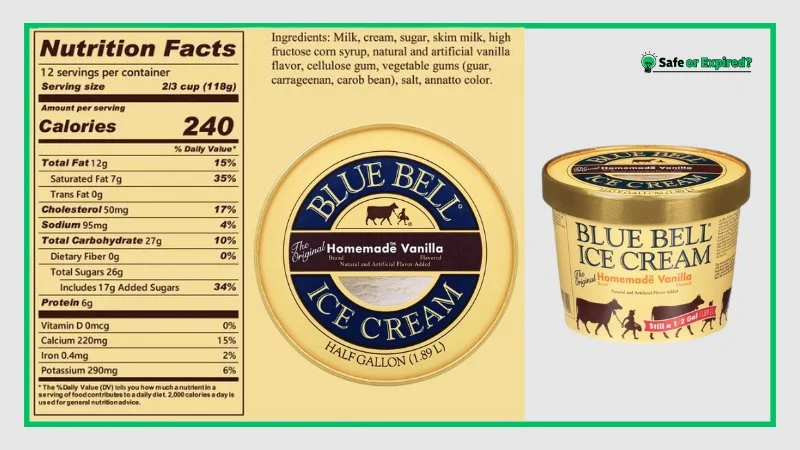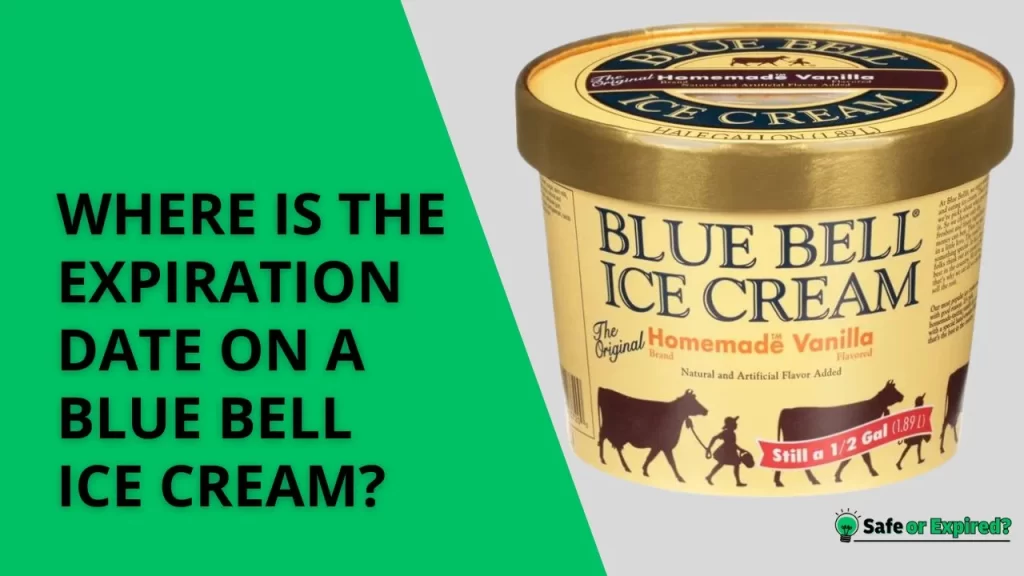Have you ever wondered, “Where is the expiration date on Blue Bell ice cream?” If so, you’re not the only one scratching your head in the frozen aisle. It’s at the bottom, and it’s in a 9-digit code (which can be confusing).
Don’t worry; this guide will clear up all the confusion, taking you through the steps to ensure that your Blue Bell ice cream is as fresh as the day it was made.
Let’s dive into the frosty details and ensure every scoop is perfect.
Where Is the Expiration Date on Blue Bell Ice Cream?
Blue Bell ice cream doesn’t have a clear expiration date. Instead, there’s a 9-digit code on the bottom of the carton. This code tells you when the ice cream was made. It is typically on the bottom of the carton, which indicates the product’s freshness and manufacturing details.
But how to read a 9-digit expiration date blue bell ice cream?
The 9-digit code on Blue Bell cartons mixes details about when and where the ice cream was made. The first part tells us about the place it was made, and the rest is a special date showing the year’s day it was made (blue bell code date). This helps you understand how fresh the ice cream is without using a regular expiration date.
For more information on various types of labels read the article Food Expiration Labels.
Once you find the expiration date on your Blue Bell Ice Cream, you might start wondering about other items in your kitchen. How do we ensure everything else is fresh and safe? If you’re into fitness, you probably use Muscle Milk. To keep it in top shape, check out our storage tips in “Does Muscle Milk Expire? 6 Storage Tips & Safety Guide.”
What To Do When There Is No Expiration Date on Blue Bell Ice Cream?
If there’s no expiration date or 9-digit code on your Blue Bell ice cream, assess its freshness by examining the texture, smell, and appearance. If it smells fresh, looks creamy without ice crystals, and has a smooth texture, it’s likely good to enjoy.
Check the Entire Package
First things first, give your ice cream carton a thorough check-over. Sometimes, the date or code might be in a hard-to-see spot, or the ink could be faded. Look at the bottom of the carton, the sides, and even the lid. You’re searching for any numbers or letters that might give you a clue about when the ice cream was made or when it’s best to eat it.
Blue Bell ice cream containers typically have a manufacturing code that can help you determine when the product was made. This code usually includes the date of production. You can call Blue Bell’s customer service with this code, and they can tell you how long the ice cream is typically good for.
Examine How It Looks, Smells, and Feels
If you’ve searched and there’s still no date to be found, your next step is to use your senses to judge if the ice cream is still good.
- Look: Open the carton and look inside. The ice cream should have a uniform color and texture. Watch out for large ice crystals or a dried-out surface, which can happen when ice cream gets old or has been thawed and refrozen.
- Smell: Give it a good sniff. Fresh ice cream will smell sweet and, well, like the delicious flavors it’s supposed to taste like. If it smells sour or just “off,” it’s best not to eat it.
- Feel: Finally, feel the texture. Fresh ice cream should be smooth and creamy. If it feels grainy, it might have been frozen for too long.
Know How to Store It Right
Keeping your ice cream in the best condition starts with how you store it. Always keep ice cream in the back of your freezer where it’s coldest. This helps prevent those big ice crystals from forming. Also, make sure the lid is on tight after every use. This keeps out air that can dry the ice cream and cause freezer burn.
Why all of this is important? Well, the reason is you won’t be able to enjoy the nutritional benefits of the ice cream if you don’t store it correctly.

When in Doubt, Better Safe Than Sorry
If, after all these checks, you’re still not sure if your ice cream is good, it might be best to throw it out. Eating ice cream that’s gone bad could make you sick, and no treat is worth that risk. Remember, it’s better to be safe than sorry regarding food safety.
Now, you can enjoy your Blue Bell ice cream with peace of mind, even when there’s no expiration date. Always trust your instincts and your senses—they’re your best tools for determining whether food is safe to eat.
And for those who love a quick breakfast, is it okay to use pancake mix that’s been sitting around? Find out what to look for in “Can You Eat Expired Pancake Mix? [Risks and Signs]”.
Difference Between Code Dates on Blue Bell Ice Cream and Sandwiches
The main difference in code dates between Blue Bell ice cream and sandwiches lies in the packaging and format. Blue Bell ice cream typically shows a code related to production, whereas the Blue Bell ice cream sandwich expiration date may be more consumer-friendly, focusing on usage timelines.
Packaging Variations
Blue Bell Ice Cream: The code on ice cream cartons primarily tracks production details. It’s usually a mix of letters and numbers that inform about the manufacturing date and location but not an explicit expiration date.
Blue Bell Ice Cream Sandwiches: The blue bell ice cream sandwich expiration date tends to be easier for consumers to understand. It might include a clearer indication of the best before or use-by date, helping consumers decide when to enjoy the sandwich.
Code Format
Blue Bell Ice Cream: The coding system might seem cryptic at first, often requiring the interpretation of a Julian date or a batch number that refers to specifics of production rather than consumer use.
Blue Bell Ice Cream Sandwiches: Sandwiches may feature a more straightforward date format, possibly including the month, day, and year, directly informing consumers of the product’s shelf life.
Here’s a comparison table.
| Feature | Blue Bell Ice Cream | Blue Bell Ice Cream Sandwiches |
| Code Purpose | Tracks production | Indicates expiration for consumers |
| Visibility | May include Julian’s dates or batch codes | Typically clearer and more accessible |
| Date Format | May include Julian dates or batch codes | More likely to use a standard date format |
| Consumer Friendliness | Requires some knowledge to interpret | Designed for easy understanding |
This table highlights the differences in how Blue Bell communicates the freshness and safety of its ice cream products versus its ice cream sandwiches.
Tips for Extending the Shelf Life of Blue Bell Ice Cream with Proper Storage
To further extend the shelf life of your Blue Bell ice cream, consider using vacuum-sealed bags. These bags remove excess air and provide an additional layer of protection against freezer burn. Another tip is to store the ice cream at the back of the freezer, where the temperature remains most consistent. Avoid placing it near the freezer door, where temperature fluctuations are more common. You can also use a digital thermometer to ensure your freezer stays at the optimal temperature of 0°F (-18°C) or lower. These steps help keep your Blue Bell ice cream fresher for longer, ensuring you enjoy every scoop.
For more information, check out Food Storage and Preservation Techniques.
Comparing Blue Bell Ice Cream Expiration With Others
Blue Bell Ice Cream’s expiration information differs if you compare it with others. According to a study, it depends on different factors, and every ice cream reacts differently to them. Here’s a comparison table on the ice cream expiration information to give you an idea:
| Brand | Shelf Life | Storage Conditions | Date Labeling | Post-Opening Shelf Life |
|---|---|---|---|---|
| Blue Bell | 2 months | Keep frozen at 0°F | Best before | 3-4 weeks |
| Häagen-Dazs | 2 months | Keep frozen at -10°F | Best before | 3-4 weeks |
| Ben & Jerry’s | 3-4 months | Keep frozen at -5°F | Best before | 3-4 weeks |
| Breyers | 6-8 months | Keep frozen below 0°F | Best before | 3-4 weeks |
FAQs
Where Is the Expiration Date on Ice Cream? (Let’s Find Out)
The location of the expiration date on ice cream can vary by brand. Generally, it’s printed on the bottom or side of the carton. Some brands may use a production code instead of a straightforward expiration date, requiring consumers to interpret the code to determine the product’s freshness.
Where Is the Expiration Date on Ben and Jerry’s Ice Cream? (Find Out)
Ben & Jerry’s ice cream’s expiration date is typically found on the bottom of the carton. It is printed in a clear, straightforward format, making it easy for consumers to understand the product’s shelf life.
Where Is Little Debbie Ice Cream Expiration Date? (Know Now)
The expiration date on Little Debbie ice cream is usually printed on the side or bottom of the package. Like many other brands, Little Debbie uses a clear date format to help consumers quickly identify when the ice cream is best consumed.
Conclusion
As we’ve unraveled the mystery of finding the expiration date on Blue Bell ice cream, here are the key takeaways:
- Blue Bell uses a production code rather than a clear expiration date, making it unique among ice cream brands.
- Ben & Jerry’s and Little Debbie offer more straightforward expiration dates, enhancing consumer convenience.
- Understanding Blue Bell’s code is crucial for enjoying your ice cream at its freshest.
- Each brand’s dating method reflects its approach to product freshness and consumer communication.
- Always use your senses to gauge the freshness if you’re unsure about the expiration date or code interpretation.
Exploring the world of ice cream expiration dates doesn’t have to be confusing. With this guide, you can make the most out of every Blue Bell treat, ensuring every bite is as delicious as intended.

